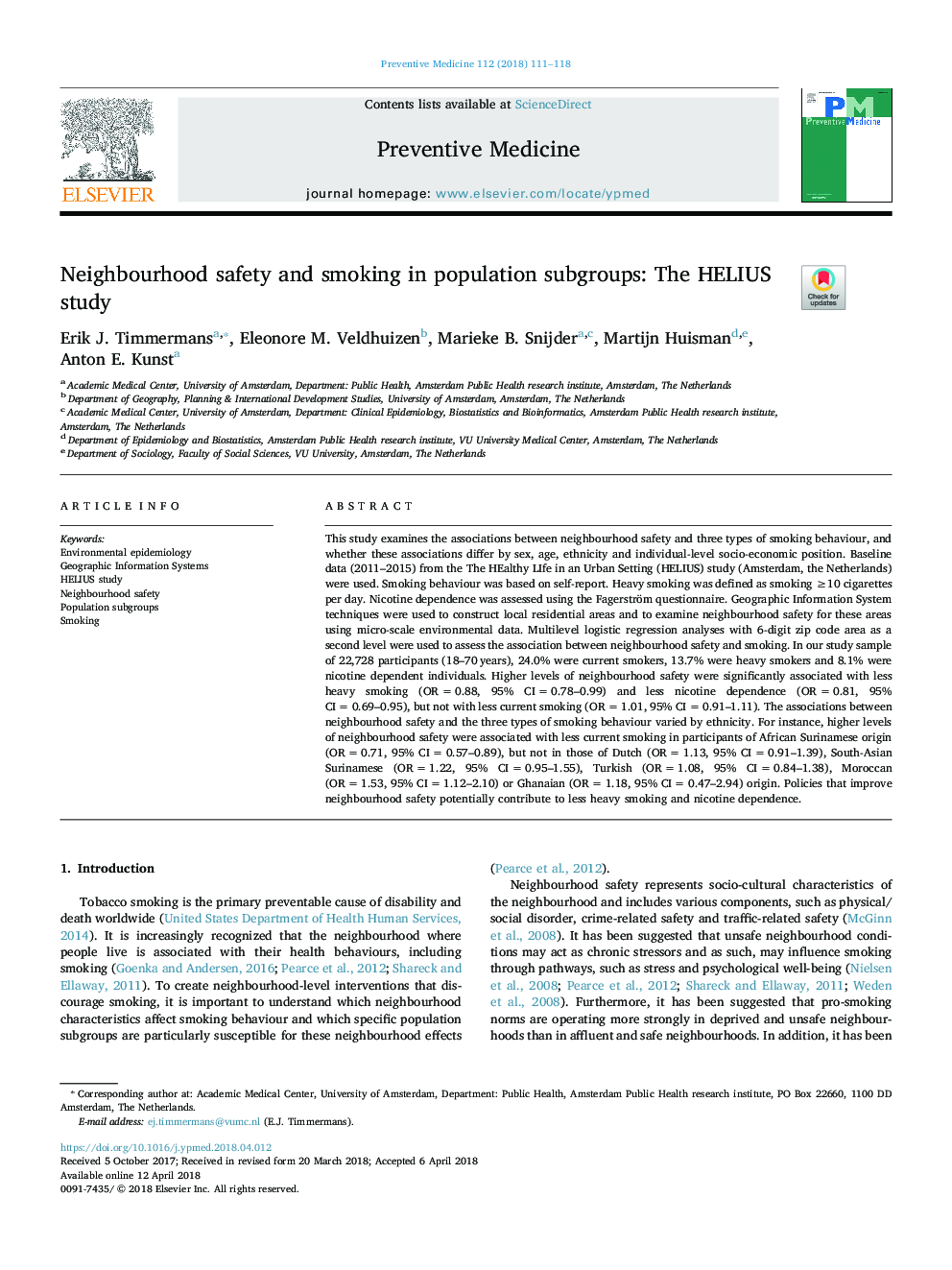| کد مقاله | کد نشریه | سال انتشار | مقاله انگلیسی | نسخه تمام متن |
|---|---|---|---|---|
| 8693495 | 1581600 | 2018 | 8 صفحه PDF | دانلود رایگان |
عنوان انگلیسی مقاله ISI
Neighbourhood safety and smoking in population subgroups: The HELIUS study
دانلود مقاله + سفارش ترجمه
دانلود مقاله ISI انگلیسی
رایگان برای ایرانیان
کلمات کلیدی
موضوعات مرتبط
علوم پزشکی و سلامت
پزشکی و دندانپزشکی
طب مکمل و جایگزین
پیش نمایش صفحه اول مقاله

چکیده انگلیسی
This study examines the associations between neighbourhood safety and three types of smoking behaviour, and whether these associations differ by sex, age, ethnicity and individual-level socio-economic position. Baseline data (2011-2015) from the The HEalthy LIfe in an Urban Setting (HELIUS) study (Amsterdam, the Netherlands) were used. Smoking behaviour was based on self-report. Heavy smoking was defined as smoking â¥10 cigarettes per day. Nicotine dependence was assessed using the Fagerström questionnaire. Geographic Information System techniques were used to construct local residential areas and to examine neighbourhood safety for these areas using micro-scale environmental data. Multilevel logistic regression analyses with 6-digit zip code area as a second level were used to assess the association between neighbourhood safety and smoking. In our study sample of 22,728 participants (18-70â¯years), 24.0% were current smokers, 13.7% were heavy smokers and 8.1% were nicotine dependent individuals. Higher levels of neighbourhood safety were significantly associated with less heavy smoking (ORâ¯=â¯0.88, 95% CIâ¯=â¯0.78-0.99) and less nicotine dependence (ORâ¯=â¯0.81, 95% CIâ¯=â¯0.69-0.95), but not with less current smoking (ORâ¯=â¯1.01, 95% CIâ¯=â¯0.91-1.11). The associations between neighbourhood safety and the three types of smoking behaviour varied by ethnicity. For instance, higher levels of neighbourhood safety were associated with less current smoking in participants of African Surinamese origin (ORâ¯=â¯0.71, 95% CIâ¯=â¯0.57-0.89), but not in those of Dutch (ORâ¯=â¯1.13, 95% CIâ¯=â¯0.91-1.39), South-Asian Surinamese (ORâ¯=â¯1.22, 95% CIâ¯=â¯0.95-1.55), Turkish (ORâ¯=â¯1.08, 95% CIâ¯=â¯0.84-1.38), Moroccan (ORâ¯=â¯1.53, 95% CIâ¯=â¯1.12-2.10) or Ghanaian (ORâ¯=â¯1.18, 95% CIâ¯=â¯0.47-2.94) origin. Policies that improve neighbourhood safety potentially contribute to less heavy smoking and nicotine dependence.
ناشر
Database: Elsevier - ScienceDirect (ساینس دایرکت)
Journal: Preventive Medicine - Volume 112, July 2018, Pages 111-118
Journal: Preventive Medicine - Volume 112, July 2018, Pages 111-118
نویسندگان
Erik J. Timmermans, Eleonore M. Veldhuizen, Marieke B. Snijder, Martijn Huisman, Anton E. Kunst,